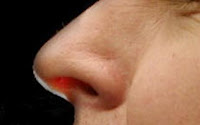More on the True Story of the evolution of the human hand
 The issue surrounds the delicate opposable thumb-endowed hand of A. erotimanis. How did this evolve? Now we must admit that this Commenter (who hides behind the moniker 'occamseraser') can do circles around us in terms of actual knowledge of human paleontology. He (or she) clearly knows the fossil record bone by bone, which we unhappily must confess that we don't.
The issue surrounds the delicate opposable thumb-endowed hand of A. erotimanis. How did this evolve? Now we must admit that this Commenter (who hides behind the moniker 'occamseraser') can do circles around us in terms of actual knowledge of human paleontology. He (or she) clearly knows the fossil record bone by bone, which we unhappily must confess that we don't.To flesh out our view, we thought making it even more convincing, we wrote a Comment of our own, a short bit of fictionalized history, that might be called "The misadventures of P'Qeeb" (since Jean Auel makes millions doing that, a point made by Holly, we felt we ought to be allowed to relay our views in that way, too). Our tale tried to bring to life some of the on-the-ground realities of our past evolution. We offered a rather, we think, totally convincing scenario for the evolution of the dextrous hand. But 'occam' suggested that perhaps A. erotimanii may have evolved their thumbs for other functions than we suggested.
We're not stupid (despite occasional appearances), and had thought of other explanations on our own, thank you very much. A thumb could be of great advantage for hitch-hiking, but no hub-caps were found at the site, so that seemed like a rather weak hypothesis. Perhaps the most obvious alternative to an origin by natural selection for a kind of sexual behavioral trait, is that the opposable thumb was evolved for picking one's nose. But, convenient as that may doubtlessly be, how could that confer a fitness advantage--enabling the picker to out-reproduce those with less manicured (so to speak) nares? Indeed, it could be argued that such behavior would actually have a negative fitness effect: who wants to do what needs to be done with someone too habituated to digital nostrillary grooming? Would they not be put off instead?
No, we don't want to be picky in what we'll accept as an adequate evolutionary explanation. But then our correspondent 'occam' suggested that the A. erotimanii may have evolved to be able to thumb their noses at their crude Alley-Ooopish paranthropine contemporaries (see our story, in the Comments, to get at taste of what they were like, the brutes).
We wrote, calmly, to defend our own ideas, by noting that they may not have had noses to thumb! Clearly 'occam' was wrong. But then in a riposte he snidely just said "who nose?", a cheap pun if there ever was one, and not one we can take lying down!
So herewith is exhibit A: the noseless Australopithecine, easily found on the web it is so obvious. Now, if you look very hard you can see that, yes, they do have a nose---of sorts. It might be pickable, but it certainly isn't thumb-able! No, occam, we're sorry (not!), but your idea simply won't fly.
Now, again, we can flesh out our argument against occam's idea in another way. How on earth would there be an advantage for the erotimanii to have a thumb or dextrous hand so they could pick (so to speak) fights with paranthropines? How could that have had any but negative effects on fitness. A picking explanation might gross out the paranthropines, but thumbing noses (even if they had noses to thumb) would have provoked the paranthropines to dangerous assaults.
Think again (and, yes, seriously if that's possible) about what we're debating when it comes to Darwinian explanations: we need to offer scenarios that are directly relevant to reproductive success. If picking one's nose, or hitchhiking, or even thumbing at wild hominids are true aspects of behavior, even if very satisfying, they are not obviously connected to reproductive success.
In thinking about this we had momentarily wondered if the dextrous hand were designed for holding broad leaves to use when blowing one's nose. But it's not clear, given the nature of Australopithecine noses, that that would not be just an uncontrollable mess. So we dropped such nose-related explanations. And we suggest that occam do the same.
Compare that to our explanation, and unless one really wants some actual evidence that has sound epistemology about it, our original explanation, immediately tied to reproductive success, is the clear winner. If one admits that there really isn't serious data on which to construct a story, well, we should acknowledge it openly. And, indeed, keep in mind that no matter how squeamish (or puritanical) you may be, the real world of animals involves many squeamish things and there's no reason they cannot be important in Nature's cold and very un-squeamish, judgments.
The bottom line is that it is not at all easy to understand how things evolved way back when in the days before blog-posts. Incredibly, that is true even when you have the bodies of the actual individuals who did the evolving! Getting correct explanations, and knowing that you have them, are great challenges that even the best of science needs to take seriously.


Comments 0
EmoticonEmoticon